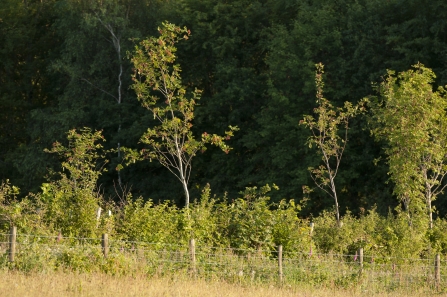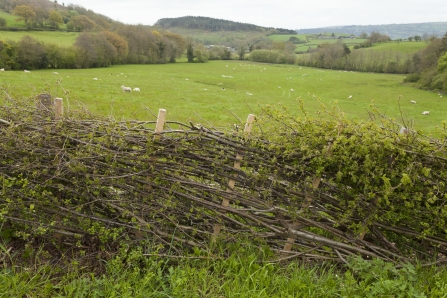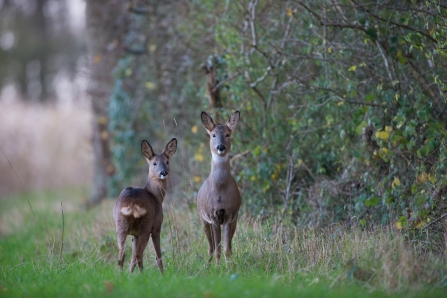Although hedgerows are important for both humans and wildlife and have been around for centuries, they are now under threat from removal and poor management. Hedgerows are important features in the landscape as they provide a wide range of services that support the healthy functioning of ecosystems. Hedgerows are beneficial as they:
- provide shade and shelter to wildlife and livestock
- act as windbreaks to protect crops
- define boundaries and provide stock-proof barriers between fields
- provide historical and cultural links
- sustain pollinators that support the growth of our food supplies
- act as wildlife corridors and offer landscape-scale connectivity
- help reduce soil erosion and water run-off on arable land
A habitat under threat
After the Second World War, financial incentives encouraged farmers to remove hedgerows to allow larger machinery into the farmed landscape in order to increase agricultural efficiency. The government policy was intended to ensure that Britain was self-sufficient in food, but it is now widely recognised that the policy went too far and as a result, tens of thousands of hedgerows were removed from the mid-20th century.
Origin of Hedgerows
Hedgerows were generally planted to show ownership boundaries, provide shelter for livestock, while also being stock-proof barriers between fields. Some have older origins and may be the remnants of ancient woodland carved out for farmland.
Often the only link between other isolated patches of wildlife habitat scattered across the landscape, thick, flora-rich hedges provide valuable nesting and foraging opportunities for a huge range of wildlife.

Ross Hoddinott/2020VISION
Ideal hedgerow habitat
The best hedges for wildlife are thick and broadest at the bottom with a range of woody species such as hawthorn, blackthorn, field maple, hazel, spindle, wayfaring tree and wild service tree occasionally overtopped by oak, ash and other standards (sometimes pollarded). Ramblers such as bramble and rose are frequent, together with climbing honeysuckle and wild clematis. At the foot of the hedge, thick herbaceous vegetation commonly includes species such as cow parsley and hedge mustard with coarse grasses, although sometimes woodland flora is found with bluebells and greater stitchwort.

Imogen Robertson
Importance of management
Many of the oldest hedges were formed when woodland was cleared, and the woodland edge was left as a boundary. Through natural succession, a hedge will always develop into a line of trees unless it is managed. To ensure a hedge provides a certain habitat for wildlife or remains thick and stock proof, active management is required to ensure their condition and survival.
Traditionally, hedges are laid carefully in late winter, before the bird nesting season and when most of the berries have been eaten. The stems are partially cut through low down, and the trunks bent over sideways and contained by stakes, creating a thick base to the hedge and filling any gaps. There are a variety of regional styles of hedge laying, and a national hedge laying championship is still run each year. Although cutting is necessary to keep a hedge thick, it is better to cut just one side or the top each year.
Neglect or unsympathetic management can be damaging to hedgerows. Over management is where a hedge is cut too frequently and too tightly over a long period, which leads to a thin, gappy and unconnected hedge. Badly timed management or cutting at the same point every year will reduce the amount of flowers and berries that are available to birds and other wildlife at crucial points in the year.

Mark Hamblin/2020VISION
Benefits of Hedgerows
Wildlife Services
Hedgerows are the most widespread semi-natural habitat in the UK and provide a range of services that help support a healthy functioning ecosystem. They provide berries, nuts, nectar and leaves at important parts of the year, which provide a good source of food for birds, mammals and invertebrates.
Hedges provide important ecological corridors, facilitating the movement of species through a landscape and from one habitat to another. In intensively famed areas, hedgerows are particularly important as they connect areas of suitable habitat and offer a refuge for wild plants and animals. The hazel dormouse is a species that struggles to move across large open areas like farmed fields, unless there is a wildlife corridor connecting one piece of habitat to another. If the condition of a hedgerow becomes too sparse or too fragmented, then it will become unsuitable and would not be able to support a dormouse population.
Thick well-structured hedges overtopped with mature trees provide valuable nesting and foraging opportunities support a variety of farmland and garden birds that use hedges for shelter, nesting opportunities and as songs posts. Hedges provide excellent wildlife habitat and are particularly important for a wide range of insects, which are attracted to honeysuckle, thorn and bramble blossom and ivy flowers. Stag beetles can be found in the tussocky vegetation at the foot of hedgerows. Bumblebees and bats, such as greater horseshoe bats, both use hedgerows as navigation aids. In the summer months, dormice will create a nest out of woven honeysuckle bark.

Don Sutherland
Regulating Ecosystems
Hedgerows help to regulate ecosystem processes such as pollination, water purification and air quality. Hedges are beneficial as they capture atmospheric pollutants, store carbon, reduce the urban island effect and help to produce oxygen.
Hedges can act as a barrier between agricultural land and nearby watercourses, helping to reduce the amount of pesticides, fertilisers and top soil entering a river channel. Trees and shrubs increase infiltration rates and help store water, which slows the flow of water during flood events. Hedgerows help to support productive farming as they sustain key pollinators and natural predators that feed on crop pests. Hedgerows with mature trees provide valuable shelter for both livestock and wildlife throughout the year and offer a great diversity of habitat niches for a range of species to colonise.

